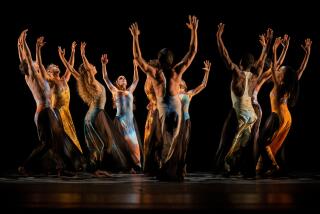DANCE REVIEW : Louise Reichlinâs New Triptych Full of Old-Style Choreography
NEWPORT BEACH â The difference between timeless and dated choreography is very subtle. The work of Los Angeles Choreographers & Dancers too often veers into the latter state. There is no such thing as lock-step progress in the evolution of contemporary dance, but sitting in front of this company at the Newport Harbor Art Museum, one gets the feeling that the last 25 years have passed it by.
Louise Reichlin directs a racially diverse ensemble of nine women and one man, some of whom are strong performers. âUrban and Tribal Dances,â her new triptych, is another reworking of 1960s modern-dance conventions. It appears to contrast up-tight cultures, represented by women in large straw hats, with the less restrained movements of beribboned girls.
In its second part, an umbrella tent with blinking green lights crawls tortoise-like onto the stage. After surveying the gallery space with a periscope, a woman wearing a black net body stocking and mismatched shoes emerges, still connected to the tent by a thick cord. Whether the choreographer here intends humor or a darker emotion is hard to discern.
The third section, a sextet, blends dance cliches from many contemporary techniques. The blank stares of the performers are accentuated by whiteface makeup decorated with abstract motifs.
Reichlinâs 1987 work, âGrounding,â and excerpts from âThe Tennis Dances,â which was made in 1979, complete her part of the program. All of Reichlinâs dances here ignore the momentous developments in dance in recent decades; the oldest of them, âTennis Dances,â is actually the strongest structurally.
Sharing the Sunday afternoon program with Reichlin was Alfred Desio, whose Zapped Taps concept got national exposure in the 1989 film âTap.â Desio is a showman, eager to please with both his rhythmic tap execution and his technological innovation. His portion of the program became a lecture-demonstration in which the computer-assisted performance was explicated for an audience heavy with wide-eyed children.
Wires on Desioâs taps send signals to a bank of blinking machines at one side of the gallery space; each step triggers a pre-programmed sound. Unfortunately, weâre so accustomed to complex electronics in concert that his performance seems little different from a simple tap dance to a recorded score, and his careful explanation only dilutes the sense of wonder he is attempting to create.
More to Read
The biggest entertainment stories
Get our big stories about Hollywood, film, television, music, arts, culture and more right in your inbox as soon as they publish.
You may occasionally receive promotional content from the Los Angeles Times.










